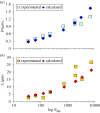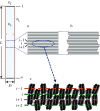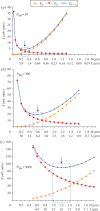The energy components of stacked chromatin layers explain the morphology, dimensions and mechanical properties of metaphase chromosomes
- PMID: 24402918
- PMCID: PMC3899872
- DOI: 10.1098/rsif.2013.1043
The energy components of stacked chromatin layers explain the morphology, dimensions and mechanical properties of metaphase chromosomes
Abstract
The measurement of the dimensions of metaphase chromosomes in different animal and plant karyotypes prepared in different laboratories indicates that chromatids have a great variety of sizes which are dependent on the amount of DNA that they contain. However, all chromatids are elongated cylinders that have relatively similar shape proportions (length to diameter ratio approx. 13). To explain this geometry, it is considered that chromosomes are self-organizing structures formed by stacked layers of planar chromatin and that the energy of nucleosome-nucleosome interactions between chromatin layers inside the chromatid is approximately 3.6 × 10(-20) J per nucleosome, which is the value reported by other authors for internucleosome interactions in chromatin fibres. Nucleosomes in the periphery of the chromatid are in contact with the medium; they cannot fully interact with bulk chromatin within layers and this generates a surface potential that destabilizes the structure. Chromatids are smooth cylinders because this morphology has a lower surface energy than structures having irregular surfaces. The elongated shape of chromatids can be explained if the destabilizing surface potential is higher in the telomeres (approx. 0.16 mJ m(-2)) than in the lateral surface (approx. 0.012 mJ m(-2)). The results obtained by other authors in experimental studies of chromosome mechanics have been used to test the proposed supramolecular structure. It is demonstrated quantitatively that internucleosome interactions between chromatin layers can justify the work required for elastic chromosome stretching (approx. 0.1 pJ for large chromosomes). The high amount of work (up to approx. 10 pJ) required for large chromosome extensions is probably absorbed by chromatin layers through a mechanism involving nucleosome unwrapping.
Keywords: biomechanics; bionanoscience; chromatin higher order structure; metaphase chromosome structure; supramolecular structures.
Figures






Similar articles
-
Stacked thin layers of metaphase chromatin explain the geometry of chromosome rearrangements and banding.Sci Rep. 2015 Oct 8;5:14891. doi: 10.1038/srep14891. Sci Rep. 2015. PMID: 26446309 Free PMC article.
-
Electron microscopy and atomic force microscopy studies of chromatin and metaphase chromosome structure.Micron. 2011 Dec;42(8):733-50. doi: 10.1016/j.micron.2011.05.002. Epub 2011 May 12. Micron. 2011. PMID: 21703860 Review.
-
Irregular orientation of nucleosomes in the well-defined chromatin plates of metaphase chromosomes.Biochemistry. 2010 May 18;49(19):4043-50. doi: 10.1021/bi100125f. Biochemistry. 2010. PMID: 20369829
-
Dense chromatin plates in metaphase chromosomes.Eur Biophys J. 2009 Apr;38(4):503-22. doi: 10.1007/s00249-008-0401-1. Epub 2009 Feb 3. Eur Biophys J. 2009. PMID: 19189102
-
Soft-matter properties of multilayer chromosomes.Phys Biol. 2021 Jul 12;18(5). doi: 10.1088/1478-3975/ac0aff. Phys Biol. 2021. PMID: 34126606 Review.
Cited by
-
Determination of motility forces on isolated chromosomes with laser tweezers.Sci Rep. 2014 Oct 31;4:6866. doi: 10.1038/srep06866. Sci Rep. 2014. PMID: 25359514 Free PMC article.
-
Hypothesis: The opposing pulling forces exerted by spindle microtubules can cause sliding of chromatin layers and facilitate sister chromatid resolution.Front Genet. 2023 Nov 24;14:1321260. doi: 10.3389/fgene.2023.1321260. eCollection 2023. Front Genet. 2023. PMID: 38075677 Free PMC article.
-
Frozen-hydrated chromatin from metaphase chromosomes has an interdigitated multilayer structure.EMBO J. 2019 Apr 1;38(7):e99769. doi: 10.15252/embj.201899769. Epub 2019 Jan 4. EMBO J. 2019. PMID: 30609992 Free PMC article.
-
Scaling Laws for Mitotic Chromosomes.Front Cell Dev Biol. 2021 Jun 11;9:684278. doi: 10.3389/fcell.2021.684278. eCollection 2021. Front Cell Dev Biol. 2021. PMID: 34249936 Free PMC article.
-
Stacked thin layers of metaphase chromatin explain the geometry of chromosome rearrangements and banding.Sci Rep. 2015 Oct 8;5:14891. doi: 10.1038/srep14891. Sci Rep. 2015. PMID: 26446309 Free PMC article.
References
-
- Rippe K. 2012. The folding of nucleosome chains. In Genome organization and function in the cell nucleus (ed. Rippe K.), pp. 139–167. Weinheim, Germany: Wiley-VCH.
Publication types
MeSH terms
Substances
LinkOut - more resources
Full Text Sources
Other Literature Sources

